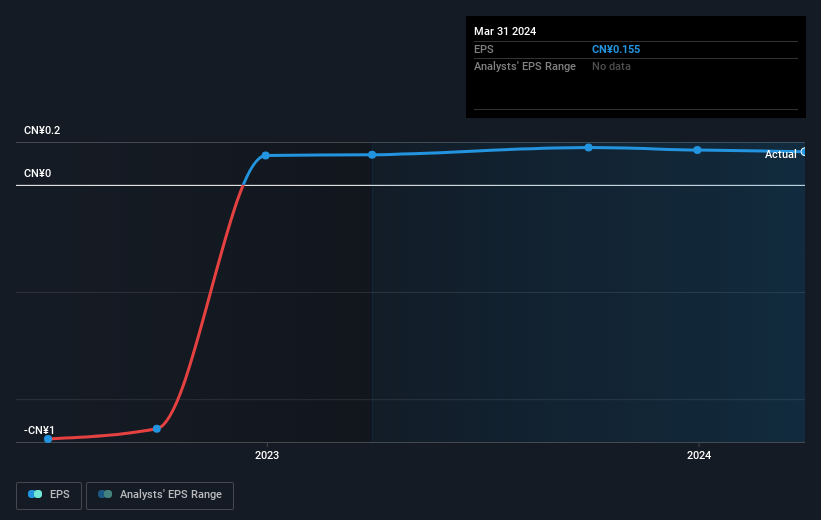- China
- /
- Trade Distributors
- /
- SHSE:600287
Jiangsu Sainty (SHSE:600287) sheds CN¥197m, company earnings and investor returns have been trending downwards for past five years

Statistically speaking, long term investing is a profitable endeavour. But unfortunately, some companies simply don't succeed. For example, after five long years the Jiangsu Sainty Corp., Ltd. (SHSE:600287) share price is a whole 53% lower. That's not a lot of fun for true believers. And some of the more recent buyers are probably worried, too, with the stock falling 39% in the last year. Furthermore, it's down 39% in about a quarter. That's not much fun for holders.
After losing 13% this past week, it's worth investigating the company's fundamentals to see what we can infer from past performance.
View our latest analysis for Jiangsu Sainty
In his essay The Superinvestors of Graham-and-Doddsville Warren Buffett described how share prices do not always rationally reflect the value of a business. One flawed but reasonable way to assess how sentiment around a company has changed is to compare the earnings per share (EPS) with the share price.
Looking back five years, both Jiangsu Sainty's share price and EPS declined; the latter at a rate of 24% per year. The share price decline of 14% per year isn't as bad as the EPS decline. So the market may previously have expected a drop, or else it expects the situation will improve.
You can see below how EPS has changed over time (discover the exact values by clicking on the image).

Dive deeper into Jiangsu Sainty's key metrics by checking this interactive graph of Jiangsu Sainty's earnings, revenue and cash flow.
What About The Total Shareholder Return (TSR)?
Investors should note that there's a difference between Jiangsu Sainty's total shareholder return (TSR) and its share price change, which we've covered above. Arguably the TSR is a more complete return calculation because it accounts for the value of dividends (as if they were reinvested), along with the hypothetical value of any discounted capital that have been offered to shareholders. Dividends have been really beneficial for Jiangsu Sainty shareholders, and that cash payout explains why its total shareholder loss of 50%, over the last 5 years, isn't as bad as the share price return.
A Different Perspective
While the broader market lost about 17% in the twelve months, Jiangsu Sainty shareholders did even worse, losing 38%. Having said that, it's inevitable that some stocks will be oversold in a falling market. The key is to keep your eyes on the fundamental developments. Unfortunately, last year's performance may indicate unresolved challenges, given that it was worse than the annualised loss of 8% over the last half decade. We realise that Baron Rothschild has said investors should "buy when there is blood on the streets", but we caution that investors should first be sure they are buying a high quality business. It's always interesting to track share price performance over the longer term. But to understand Jiangsu Sainty better, we need to consider many other factors. Case in point: We've spotted 1 warning sign for Jiangsu Sainty you should be aware of.
If you like to buy stocks alongside management, then you might just love this free list of companies. (Hint: many of them are unnoticed AND have attractive valuation).
Please note, the market returns quoted in this article reflect the market weighted average returns of stocks that currently trade on Chinese exchanges.
New: Manage All Your Stock Portfolios in One Place
We've created the ultimate portfolio companion for stock investors, and it's free.
• Connect an unlimited number of Portfolios and see your total in one currency
• Be alerted to new Warning Signs or Risks via email or mobile
• Track the Fair Value of your stocks
Have feedback on this article? Concerned about the content? Get in touch with us directly. Alternatively, email editorial-team (at) simplywallst.com.
This article by Simply Wall St is general in nature. We provide commentary based on historical data and analyst forecasts only using an unbiased methodology and our articles are not intended to be financial advice. It does not constitute a recommendation to buy or sell any stock, and does not take account of your objectives, or your financial situation. We aim to bring you long-term focused analysis driven by fundamental data. Note that our analysis may not factor in the latest price-sensitive company announcements or qualitative material. Simply Wall St has no position in any stocks mentioned.
Have feedback on this article? Concerned about the content? Get in touch with us directly. Alternatively, email editorial-team@simplywallst.com
About SHSE:600287
Jiangsu Sainty
Engages in the import and export of textiles and garments in the People’s Republic of China and internationally.
Good value with proven track record.

